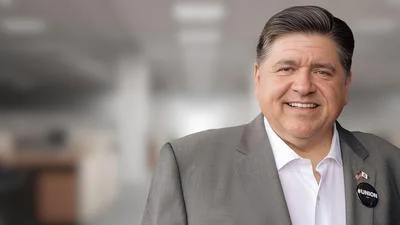Illinois Governor J.B. Pritzker | State of Illinois
Illinois Governor J.B. Pritzker | State of Illinois
Illinois Governor J.B. Pritzker says there isn't any particular COVID-19 data point that's driving his continuing demand that all the state's residents wear masks when indoors.
Only that he is watching "the numbers" and will let us know when he feels it is safe for his citizens to socialize mask-less.
"Every question that you give is a question about removing mitigations," he scolded AM-560 reporter Amy Jacobson at a downtown press conference this week. "We want to make sure that we're keeping people healthy and safe following the guidelines that doctors are offering for us."
One of those doctors, Chicago Public Health Commissioner Allison Arwady, isn't making any promises. She said she believes wearing masks will become even more important during the coming winter months.
"That's when we usually start to see respiratory viruses like flu really take off and we'll have a better sense," Arwady said last weekend. "My concern is I don't want to say hooray, let's take the mask off, two weeks later we have to put them back on."
On Arwady's advice, Chicago Mayor Lori Lightfoot ordered all Chicago residents wear masks indoors as of Aug. 20.
Pritzker issued an executive order mandating masks indoors on Aug. 26.
Illinois remains one of the only state's requiring masks indoors, and Pritzker is one of the only governors refusing to provide a mask mandate end date, prompting a lawsuit against him by parents and children across the state.
Nevada's Democrat Governor Steve Sisolak instituted an indoor mask mandate on July 30. He also gave specific "case positivity" criteria for when he will lift it: when less than 10 percent of those tested for COVID-19 have it.
Illinois reported "case positivity" rate is 1.3 percent.
Others include New Mexico, where Democrat Gov. Michelle Lujan Grisham is officially requiring masks indoors until Nov. 12. She also started her requirement on Aug. 20.
A statewide mask mandate by Democrat Louisiana Governor John Bel Edwards is set to expire on Oct. 27.
Washington, D.C. Democrat Mayor Muriel Bowser imposed another indoor mask mandate on July 28; like, Pritzker, she has refused to say when she might lift it.
The efficacy of wearing a mask to stop infectious disease is bolstered by strong political belief, if it isn't supported by any actual scientific evidence.
A University of Illinois at Chicago study found that "cloth masks and face coverings are likely to have limited impact on lowering COVID-19 transmission, because they have minimal ability to prevent the emission of small particles.. and offer limited personal protection with respect to small particle inhalation."
"Does that Face Mask Really Protect You," a 2010 research article by Dr. Larry E. Bowen of the Southern Research Institute in Birmingham, Ala., fit various types of masks on a mannequin to study their effectiveness, found that wearing surgical, bandana and dust masks offer "very little protection" and concluded that "wearing these face masks may produce a false sense of protection."
A Center for Biosecurity Disease paper, "Mitigation Measures in the Control of Pandemic Influenza," reported that “studies have shown that the ordinary surgical mask does little to prevent inhalation of small droplets of influenza virus (because) the pores in the mask become blocked by moisture from breathing, and the air stream simply diverts around the mask.”
That paper recounted that when schools closed for a winter holiday during the 1918 pandemic in Chicago, “more influenza cases developed among pupils than when schools were in session.” “To close schools.. is not only impracticable but carries the possibility of a serious adverse outcome," the author concluded.





 Alerts Sign-up
Alerts Sign-up